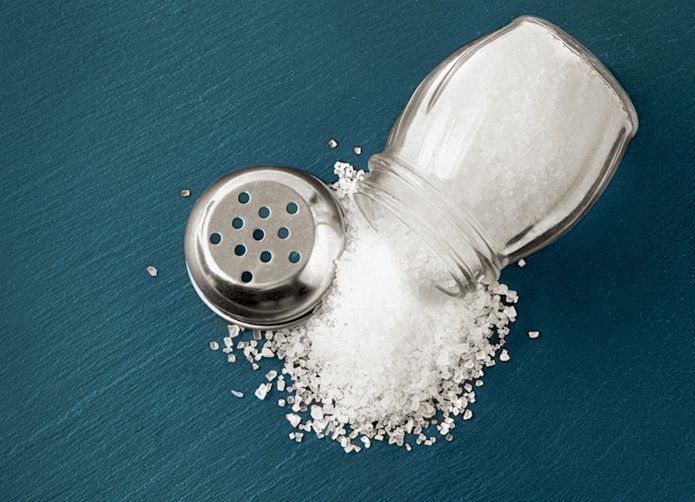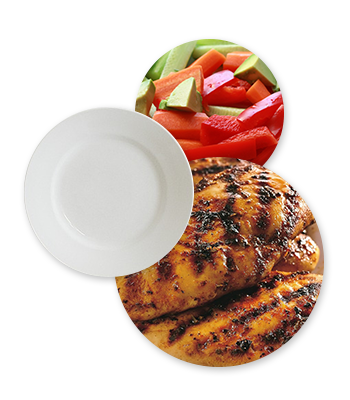Understanding the Relationship Between Salt and Diabetes
Reviewed by: Melissa Herrmann Dierks , RDN, LDN, CDCES
The 2020–2025 edition of Dietary Guidelines for Americans recommends that all adults limit their sodium intake. For people with diabetes, this recommendation is especially important because it can lower blood pressure and reduce your risk of developing cardiovascular disease. The good news is that managing your sodium intake and diabetes doesn’t have to come at the cost of enjoying good food. The key to eating delicious, low-sodium meals is learning how to grocery shop, cook, and dine out on a “sodium budget.”
Most sodium consumed in the United States comes from salt added during food processing and preparation. Many restaurant foods are also high in sodium. Fortunately, learning to read the Nutrition Facts panel on food labels to make healthier choices, trying new recipes, cooking at home more often, and flavoring foods with herbs and spices instead of spice mixes that may contain salt or sodium can all help lower your sodium intake.
At the end of the day, it’s a matter of balance, so it’s important to develop a meal plan that supports your individual health management goals. In this article, we’ll take a closer look at the relationship between salt, sodium, and diabetes to help you make more informed food choices.
- What is the difference between salt & sodium?
- What is the sodium and glucose relationship?
- Can high sodium levels increase your risk for type 2 diabetes?
- Can high sodium levels increase your risk for heart disease?
- How much sodium should you consume per day?
- Which foods contain high sodium levels?
- 7 tips to lower your sodium intake
What is the Difference Between Salt & Sodium?
The words salt and sodium are often used interchangeably, though they aren’t quite the same. Salt refers specifically to sodium chloride, a crystalline chemical compound — in other words, the sea salt or table salt that is kept in a shaker and added to meals. Sodium, on the other hand, is an essential mineral and is one of the chemical elements found within salt. Sodium, which is regulated by the kidneys, helps control the body’s fluid balance and supports muscle and nerve function. Sodium is naturally occurring in many foods; it’s also manufactured into processed foods.
An easy way to remember the difference between salt and sodium is to think of it this way: Salt is something you buy at the supermarket; sodium is found in foods.
What Is the Sodium and Glucose Relationship?
Your sodium intake does not have a direct effect on your blood sugar readings. It can, however, affect your cardiovascular health, including raising your blood pressure and increasing your risk of stroke. Your sodium intake can also affect the health of your kidneys. Processed foods are often high in sodium, as well as fat and calories, making weight management more challenging.
Can High Sodium Levels Increase Your Risk of Type 2 Diabetes?
Although a high-sodium diet does not necessarily lead to type 2 diabetes, having hypertension (high blood pressure) greater than 140/90 mm Hg or being on therapy for hypertension have been identified as risk factors. Since sodium intake can affect blood pressure, it can increase your risk of developing type 2 diabetes. High-sodium diets are often high in fat and calories, which can lead to weight gain and even obesity, which are also risk factors.
Can High Sodium Levels Increase Your Risk of Heart Disease?
According to the American Heart Association (AHA), too much sodium in the bloodstream can pull water into your blood vessels, which increases the amount of blood flowing through them and, as a result, your blood pressure. The AHA also states that:
Over time, high blood pressure may overstretch or injure the blood vessel walls and speed the build-up of gunky plaque that can block blood flow. The added pressure tires out the heart by forcing it to work harder to pump blood through the body.
High blood pressure is one of the leading risk factors for heart disease. In people with diabetes, high blood pressure can also affect blood vessels in the eyes and kidneys, leading to decreased function and chronic problems. Since people with type 1 or type 2 diabetes are already at a higher risk of vascular complications, it’s important to be mindful of your blood pressure and to monitor your sodium intake wherever possible.
How Much Sodium Should You Consume per Day?
The American Diabetes Association (ADA) recommends that people with diabetes restrict their sodium intake to less than 2300 mg per day. People with diabetes who have high blood pressure, chronic kidney disease, or who are over the age of 51 may benefit from reducing sodium intake even more, to as low as 1500 mg/day. Ultimately, your daily sodium intake should be tailored to your individual health and lifestyle. You can consult a Registered Dietitian Nutritionist for individualized recommendations.
Which Foods Contain High Sodium Levels?
Sodium is found in foods from all categories across the food supply. That said, certain foods have a higher sodium content than others, whether it’s naturally occurring or added in. For example, processed foods such as frozen dinners and potato chips tend to have high sodium levels than fresh foods such as fish, chicken, fruits, and vegetables.
Other examples of high-sodium foods include:
- Pizza and frozen meals
- Deli meats
- Canned foods
- Pickles and olives
- Seasoning mixes that contain salt
- Boxed rice or potato mixes
- Processed cheeses
- Tomato sauce
The best way to determine a food item’s sodium content is to read its nutrition label. The ADA offers a helpful guide on how to make sense of food labels and make smart, healthy choices.
It’s important to note that people with diabetes don’t need to completely eliminate higher sodium foods. The most important thing is to eat a variety of healthy foods and include high-sodium foods on occasion. Your healthcare professional can help you with which foods — with high sodium content or otherwise — to incorporate into your diet and which ones to limit based on your unique health requirements.
7 Tips to Lower Your Sodium Intake
Lowering your sodium intake is often as easy as making a few simple changes to your eating patterns. Here are a few tips to help you get started:
- Make healthy choices in each section of the supermarket:
- Fruits & Vegetables — Fresh and canned fruits are naturally low in sodium. Choose fresh veggies or frozen ones with no sauce. Buy canned vegetables that say “40% less sodium” or “low sodium,” or drain the liquid off.
- Grains — Compare food labels on breads, crackers, breakfast cereals, and pasta and choose those with lower sodium. Choose unseasoned whole grains such as brown rice, oats, barley, and quinoa.
- Dairy — Milk and yogurt contain only small amounts of naturally occurring sodium, while processed cheeses have higher sodium content. Look for low-sodium cheese options such as Boar’s Head brand low-sodium cheeses.
- Protein — Shop for unseasoned meat, poultry, and fish, and choose low-sodium deli meats such as the reduced sodium varieties sold by Boar’s Head or Hillshire Farms. Avoid high-sodium meats such as sausage, bacon, and canned meats.
- When cooking, try swapping out salt for other herbs and spices:
- Check out the Department of Health & Human Services’ list of tasty salt-free alternatives.
- Read labels on seasoning blends, as they can be high in sodium. Experiment with sodium-free seasoning blends such as Mrs. Dash and McCormick’s Perfect Pinch.
- Don’t keep a salt-shaker on the table.
- Keep in mind that traditional salt substitutes are often high in potassium. If you take a potassium medication, you may need to avoid these.
- Experiment with using reduced- or low-sodium versions of your favorite snacks and condiments.
- When dining out:
- Avoid foods with sauces.
- Focus on baked, broiled, or grilled entrees instead of fried or battered foods, as these tend to be high in sodium content.
- Request that no salt be added to your meal.
- Make healthy swaps such as choosing a baked potato instead of French fries.
- Incorporate potassium-rich foods, such as sweet potatoes, leafy greens, unsalted nuts, and a variety of fruits and vegetables into your diet. According to the AHA, potassium helps counter the effects of sodium and can lower your blood pressure. Aim for 2½ cups of non-starchy veggies each day. Again, if you take a potassium medication, you may need to avoid these foods.
- Consider following the Dietary Approaches to Stop Hypertension — more commonly known as the DASH — eating plan. The DASH diet includes fruits, vegetables, lean meats and fish, whole grains, beans and nuts, vegetable oils, and fat-free and low-fat dairy products. It’s heart-healthy, since it consists of foods that are low in sodium and saturated fats, but high in fiber and protein. The DASH diet is also high in magnesium, potassium, and calcium, which are minerals that help regulate blood pressure.
Your registered dietitian nutritionist (RDN) can help you get started with a DASH eating plan. You can also learn more about the DASH diet and find dietitian-approved recipes in these cookbooks:
- “DASH Diet for Two: 125 Heart-Healthy Recipes to Lower Your Blood Pressure Together” by Rosanne Rust
- “DASH for Weight Loss: An Easy-to-Follow Plan for Losing Weight, Increasing Energy, and Lowering Blood Pressure” by Jennifer Koslo, PhD RDN
- “The Mediterranean DASH Diet Cookbook: Lower Your Blood Pressure and Improve Your Health” by Abbie Gellman, MS, RD, CDN
- “DASH Diet for Dummies, 2nd Edition” by Sarah Samaan, Rosanne Rust, and Cindy Kleckner
- Consult your healthcare professional before making any changes to your eating pattern to see which foods they recommend and to ensure that your choices support your overall health goals.



![Blood Sugar Levels: What is Normal, Low or High, Target Ranges & More [w/ Downloadable Chart]](https://agamatrix.com/wp-content/uploads/2019/11/Blood_Sugar_Levels_Chart_Feature_Image-1-1024x683.jpg)
![Diabetes & Vegetarian Diets: Tips & Meal Options [Plus, Download a Free Meal Plan Chart]](https://agamatrix.com/wp-content/uploads/2020/07/Vegetarian_Diets_And_Diabetes_Blog_Header_Image-1.jpg)